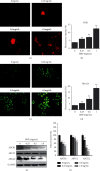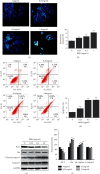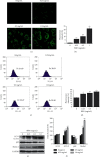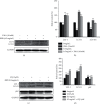Babao Dan Reverses Multiple-Drug Resistance in Gastric Cancer Cells via Triggering Apoptosis and Autophagy and Inhibiting PI3K/AKT/mTOR Signaling
- PMID: 34306145
- PMCID: PMC8285167
- DOI: 10.1155/2021/5631942
Babao Dan Reverses Multiple-Drug Resistance in Gastric Cancer Cells via Triggering Apoptosis and Autophagy and Inhibiting PI3K/AKT/mTOR Signaling
Abstract
Multidrug resistance (MDR) is a critical reason for cancer chemotherapy failure. Babaodan (BBD) is a famous traditional Chinese patent medicine reported to have antigastric cancer activity. However, the roles and molecular mechanisms of the reversal of MDR of gastric cancer by BBD have not been well described until now. Therefore, the purpose of this study was to elucidate further the role of BBD in reversing the MDR of gastric cancer cells and its specific regulatory mechanism via in vitro experiments. To verify our results, MTT, Doxorubicin (DOX) staining, Rhodamin123 (Rho123) staining, DAPI staining, Annexin V-FITC, propidium iodide (PI), Cyto-ID, and western blot assays were performed. To determine whether BBD triggers apoptosis and autophagy through the PI3K/AKT/mTOR signaling, we also applied 3-methyladenine (3-MA), chloroquine (CQ), and 740Y-P (an activator of PI3K). The results showed that BBD reversed the MDR and induced apoptosis and autophagy of SGC7901/DDP cells. Pathway analyses suggested BBD inhibits PI3K/AKT/mTOR pathway activity and subsequent apoptosis-autophagy induction. Inhibition of autophagy with 3-MA and chloroquine (CQ) was performed to confirm that BBD promoted autophagy. PI3K agonist, 740Y-P, further verified BBD inhibition of PI3K/AKT/mTOR pathway activation. In conclusion, BBD may reverse the MDR of gastric cancer cells, induce apoptosis, and promote autophagy via inactivation of the PI3K/AKT/mTOR signaling pathway.
Copyright © 2021 Jinyan Zhao et al.
Conflict of interest statement
The authors declare that there are no conflicts of interest regarding the publication of this paper.
Figures







Similar articles
-
Babaodan inhibits cell growth by inducing autophagy through the PI3K/AKT/mTOR pathway and enhances antitumor effects of cisplatin in NSCLC cells.Am J Transl Res. 2019 Aug 15;11(8):5272-5283. eCollection 2019. Am J Transl Res. 2019. PMID: 31497240 Free PMC article.
-
Deoxynivalenol-Induced Cytotoxicity and Apoptosis in IPEC-J2 Cells Through the Activation of Autophagy by Inhibiting PI3K-AKT-mTOR Signaling Pathway.ACS Omega. 2019 Oct 24;4(19):18478-18486. doi: 10.1021/acsomega.9b03208. eCollection 2019 Nov 5. ACS Omega. 2019. PMID: 31720552 Free PMC article.
-
Negative regulation of PI3K/AKT/mTOR axis regulates fibroblast proliferation, apoptosis and autophagy play a vital role in triptolide-induced epidural fibrosis reduction.Eur J Pharmacol. 2019 Dec 1;864:172724. doi: 10.1016/j.ejphar.2019.172724. Epub 2019 Oct 7. Eur J Pharmacol. 2019. PMID: 31600493
-
The Two-Faced Role of Autophagy in Endometrial Cancer.Front Cell Dev Biol. 2022 Mar 31;10:839416. doi: 10.3389/fcell.2022.839416. eCollection 2022. Front Cell Dev Biol. 2022. PMID: 35433698 Free PMC article. Review.
-
Research Progress and Prospects of Autophagy in the Mechanism of Multidrug Resistance in Tumors.J Oncol. 2022 Jan 30;2022:7032614. doi: 10.1155/2022/7032614. eCollection 2022. J Oncol. 2022. PMID: 35136409 Free PMC article. Review.
Cited by
-
Progress in the studies on the molecular mechanisms associated with multidrug resistance in cancers.Acta Pharm Sin B. 2023 Mar;13(3):982-997. doi: 10.1016/j.apsb.2022.10.002. Epub 2022 Oct 7. Acta Pharm Sin B. 2023. PMID: 36970215 Free PMC article. Review.
-
Taurocholic Acid and Glycocholic Acid Inhibit Inflammation and Activate Farnesoid X Receptor Expression in LPS-Stimulated Zebrafish and Macrophages.Molecules. 2023 Feb 21;28(5):2005. doi: 10.3390/molecules28052005. Molecules. 2023. PMID: 36903252 Free PMC article.
-
Babaodan overcomes cisplatin resistance in cholangiocarcinoma via inhibiting YAP1.Pharm Biol. 2024 Dec;62(1):314-325. doi: 10.1080/13880209.2024.2331060. Epub 2024 Apr 4. Pharm Biol. 2024. PMID: 38571483 Free PMC article.
-
Potential Therapeutic Action of Autophagy in Gastric Cancer Managements: Novel Treatment Strategies and Pharmacological Interventions.Front Pharmacol. 2022 Jan 28;12:813703. doi: 10.3389/fphar.2021.813703. eCollection 2021. Front Pharmacol. 2022. PMID: 35153766 Free PMC article. Review.
-
A review on cullin neddylation and strategies to identify its inhibitors for cancer therapy.3 Biotech. 2022 Apr;12(4):103. doi: 10.1007/s13205-022-03162-x. Epub 2022 Mar 29. 3 Biotech. 2022. PMID: 35463041 Free PMC article.
References
-
- Pan H. W., Li S. C., Tsai K. W. MicroRNA dysregulation in gastric cancer. Current Pharmaceutical Design. 2013;19:1273–1284. - PubMed
LinkOut - more resources
Full Text Sources
Research Materials
Miscellaneous

